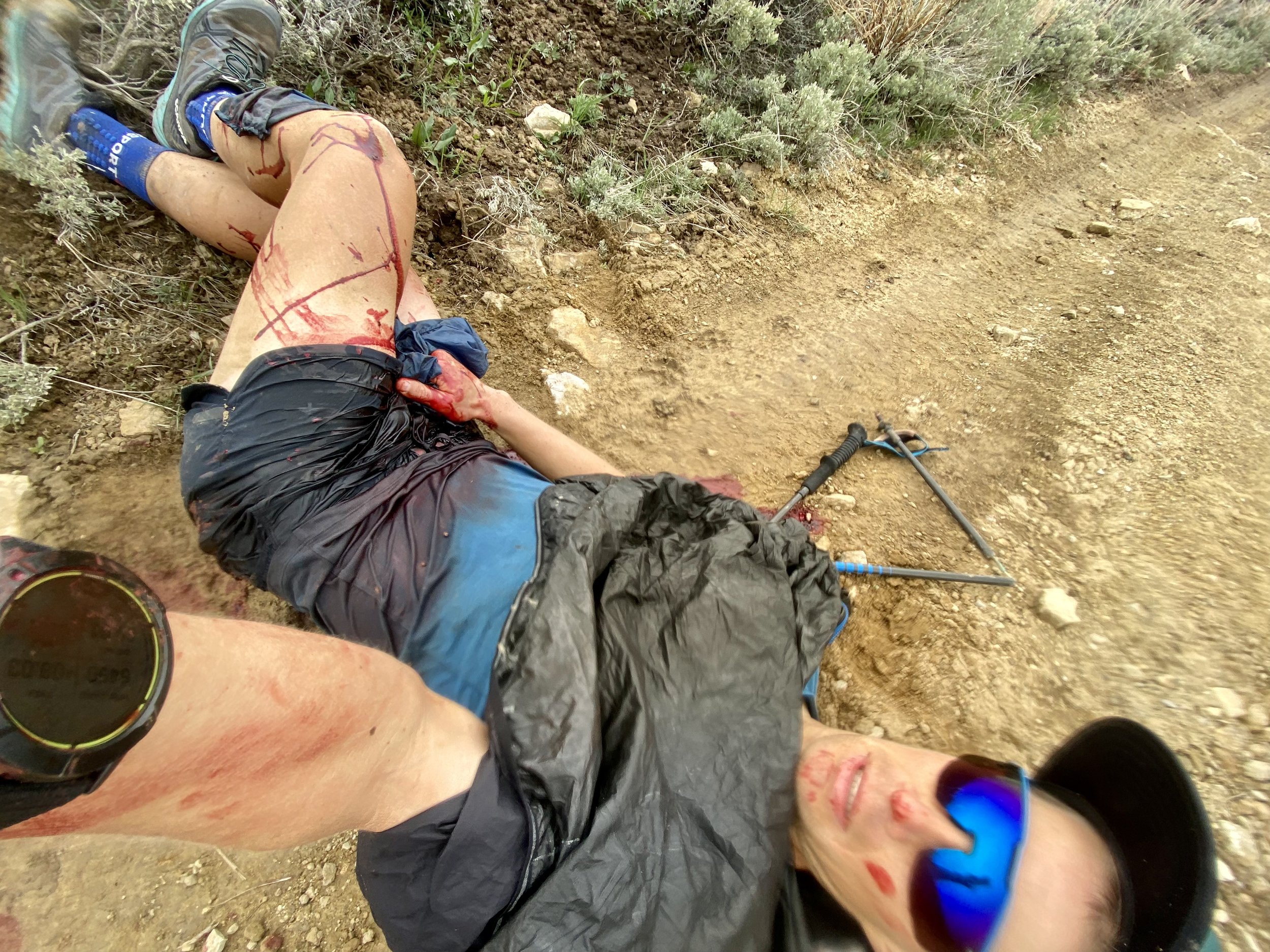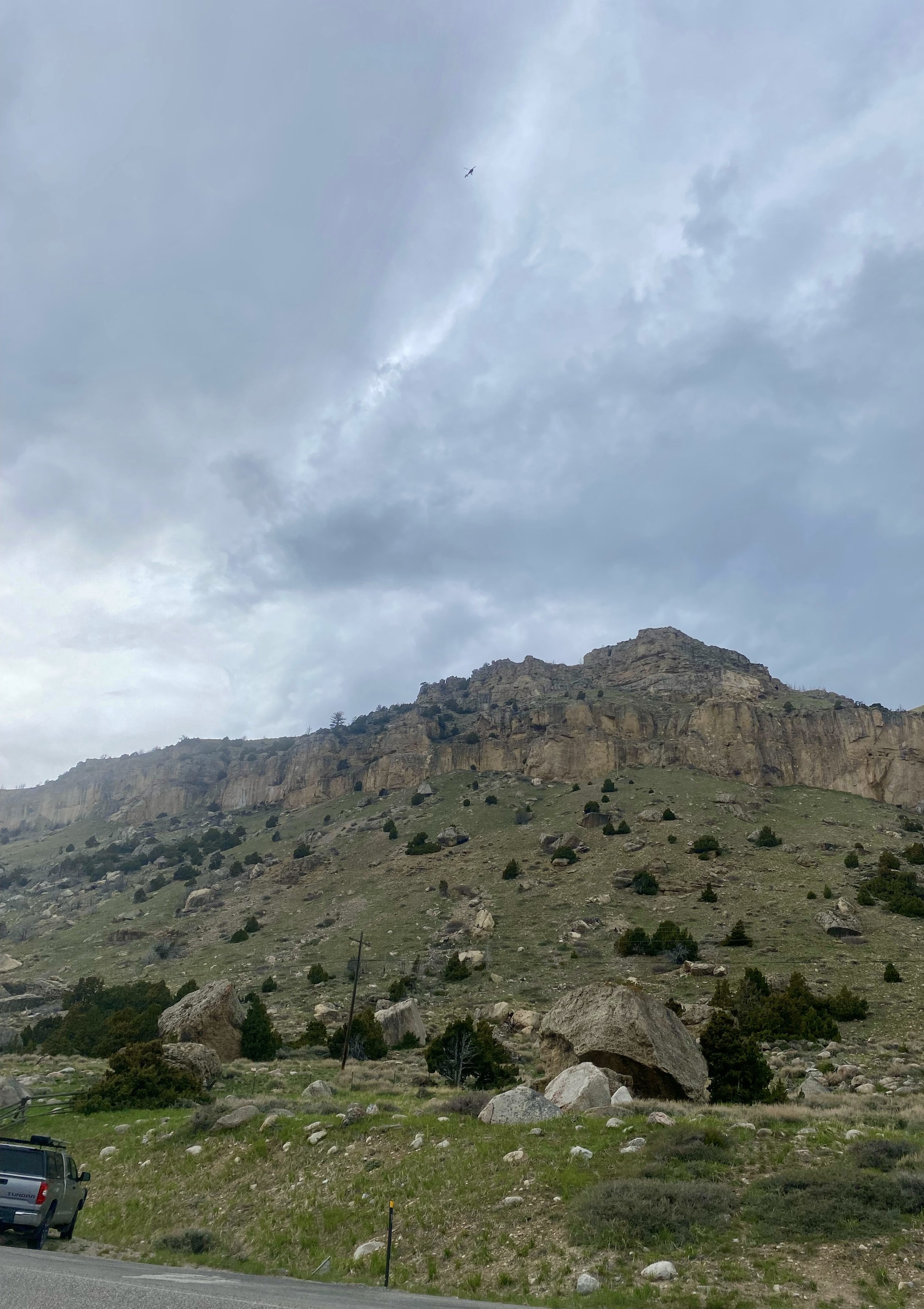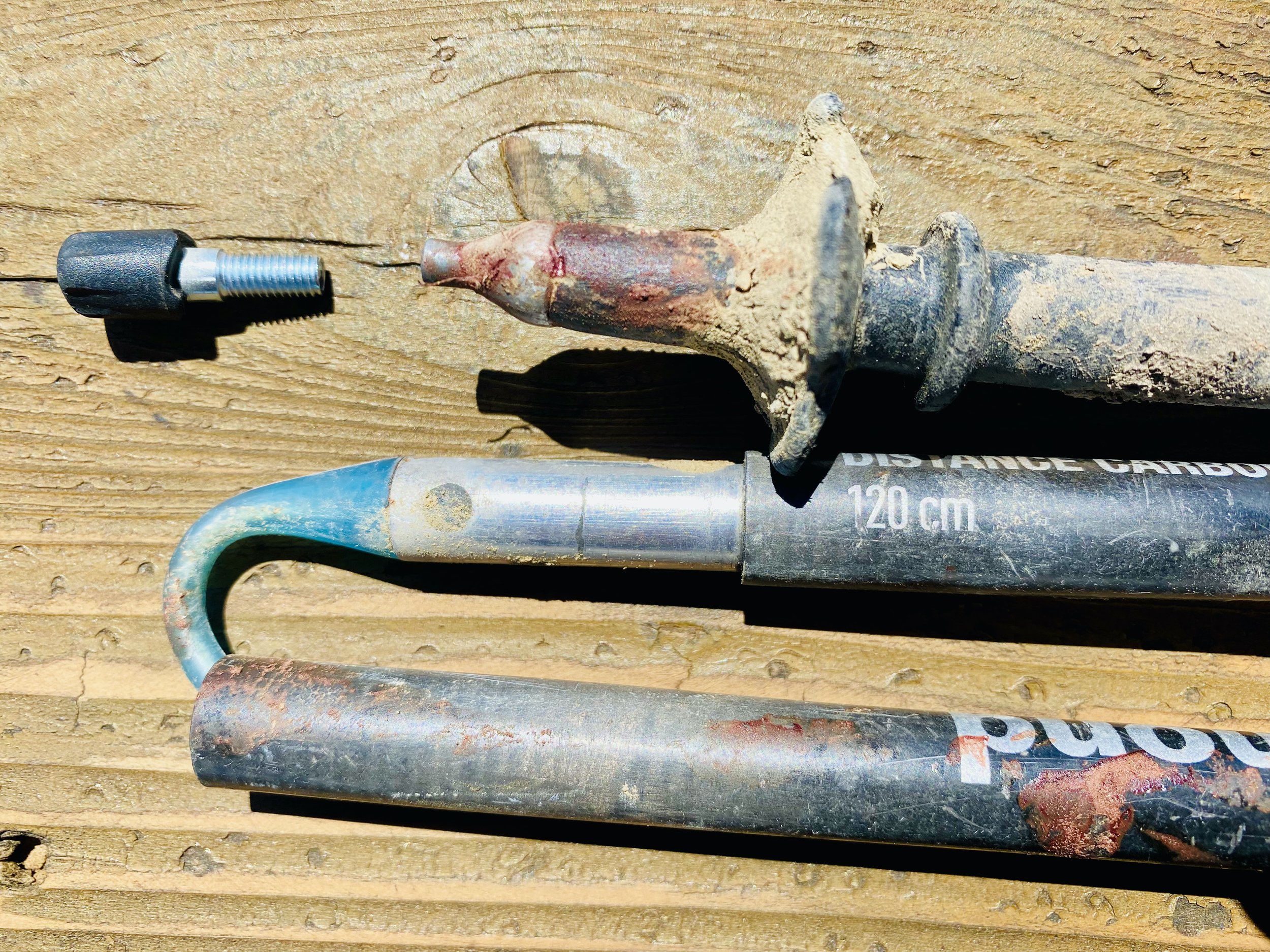Accidents Happen
This is the longwinded version of the accident that I experienced on Sunday, May 22nd. I’m mostly writing this so that maybe it can help you avoid an accident in the future, and to also be a bit therapeutic for myself. Hopefully it helps someone else out there.
————
As I drove up to Sinks Canyon for my last long run of the week, I consciously reminded myself to be careful today, as I was carrying some fatigue in my legs and was just about in peak training in preparation for Lavaredo 120K. These sorts of runs in the past have led to an ankle sprain, and making it to the starting line healthy was a top priority. I parked my car in the middle of Sinks Canyon, planning on roughly three 10-mile loops, using my car as an aid station twice. I had been diligently practicing with my poles for the last 9-months in preparation for a season of steep European mountain running, and was annoyed with myself for actually forgetting my poles on the first loop. I made a mental reminder to be sure to pick them up later. My route was altered and extended a bit along the way as I bumped into a mother moose who made it abundantly clear she wanted me nowhere near her tiny newborn calf.
My second loop started at mile 17, about 2.5 hours into the run, and I was happy to run and hike up Fairfield Hill which is undoubtedly my favorite route in Sinks Canyon. The weather had been mostly comfortably cool, but humid, so I was already soaked in sweat. Slipping a wind jacket over my pack made sense as I climbed up into the chilly wind. I passed a heard of elk just before reaching the Fairfield Saddle, and then turned around to hustle back down 3.5 miles and 2,200 feet to my car to resupply before the final 60 minutes of running. Instead of stowing my poles on my pack as I usually do for the downhills, I decided to just fold them up and carry them in my hands since the stow system was under my windbreaker. I rarely carry poles like this, and when I do I always carry them with the tips pointing down just because that has felt slightly safer.
Enjoying the Fairfield Saddle just a couple weeks prior to the accident
20.5 miles into the run my legs were just starting to feel a bit tired. After easing my fatigued legs into the descent I was starting to let loose and allow momentum take me when I kicked a rock and started hurtling forward. These sort of falls are just a part of trail running—I’d say it happens to me maybe 3-4 times a year—they always hurt, leave you scraped up, and just generally suck. Typically when I hit the ground in these moments I lay there for a few seconds and ask myself “am I ok?” I take inventory and the answer has always been “yes.”
On this particular day when I hit the ground I remember gasping out loud over and over “I’m not ok, I’m not ok!” but I didn’t actually know why. As it turns out, the handle end of my pole hit the ground first (while still in my hand) and the force of me running downhill at low 6-minute miles landed on the sharp end of my pole pretty much right where my right thigh meets the pelvis. I took a look at myself and was horrified to see blood pulsating out of my shorts at a flow rate that did not even seem possible—something more akin to a bubbling faucet. I instantly assumed that it was an arterial bleed and was well aware that without prompt treatment this injury would kill me. I only panicked for just a few seconds, mumbling “I need some help! I need some help!” but also swiftly understood that no one was going to help me (at least not for awhile) and that if I wanted to live I needed to get to work immediately.
I worked at a backpacking oriented summer camp in Montana back in 2007-2009, and part of our training each year was to get certified in Wilderness First Aid. I’ve certainly reviewed this knowledge base over the years, and did imagine situations where it might come in handy. Fortunately our brains can be kind of amazing and I remembered quite a bit of my training. I knew with bleeds like this in a wilderness setting all you can really do is slow the blood flow as much as possible and get help as fast you can. I rammed two finger directly into the would and pushed as hard as I could. This is as disgusting and painful as it sounds. I was laying in the middle of a rough two-track, so I scooted my feet to the uphill side of the road to try to get in “shock position” so that blood would stay in my organs longer and not just go out through my leg. The blood was still really pouring out, so I decided to use my wind jacket to help stifle the flow. I was hoping broader pressure in addition to water resistant fabric would help keep more blood in me. I had an additional light weight rain jacket with me that I put over myself to help with shock, and because I knew I would eventually get cold given the weather conditions and my circumstance.
Crossing my legs to restrict blood flow
Next, it was time to attempt to call for help. I used my teeth to open up my pack and get out my phone, and was beyond relieved to see that I had two bars of LTE service. Phone service in Sinks Canyon is super spotty, and often just kind of comes and goes. I instantly knew to call my lovely wife Jenny because I could explain to her exactly where I was. As calmly as I could I told her that I was about a mile below the Fairfield Saddle on Vanessa Street with an arterial bleed and that I needed help as fast as humanly possible. She fought off shock, confirmed what I had said, and hung up. Maybe 10-minutes later she called back and I gave her a few more details to send onto Search and Rescue. I decided to call 911 myself, just to emphasize the point that I needed help extra fast. As soon as my call connected to 911 it was dropped, and I was completely out of phone service. Shit. I felt really bad about this because I assumed Jenny would try and get through to me again and I knew she wouldn’t be able to, and I can only imagine what kind of thoughts that would leave her with.
I put my tiny running pack under my head, adjusted my pressure on the wound and took stock of the situation. Help would be on the way eventually, but undoubtedly not as fast as I wanted it to be. So far I was thinking clearly and was probably not going to die in at least the next couple of minutes. As long as I could be patient and not pass out (meaning I could no longer put pressure on the wound) I had a chance of getting through this alive. I used every tool in my mental toolbox to pass the time and keep it together. I used breathing techniques to try and slow my heart rate (and thus the blood flow), I attempted to look around and lose myself in the scenery a bit, and I even tried to normalize the situation by taking a few photos while laying there. I sometimes struggle with prayer—so often I hear peoples prayers sound like a kid on Santa’s lap reciting their self-minded wish list, and in a world with so much suffering I can’t imagine why I would bother God with anything in my life—but I did decide it was prudent to say thank you for the phone service, and at least ask for an additional dose of patience and strength.
This went well enough for awhile, until the breeze started to pick up, and my sweat and blood soaked clothing became extremely cold. I had anticipated this would happen, but decided it was not too big of deal because I certainly wasn’t going to freeze to death before I bled to death. However I undoubtedly underestimated how challenging it would be—what started as teeth chattering shivering slowly turned into whole body shaking as the icy wind blew straight down Fairfield Hill. I struggled to keep pressure on the wound as my whole body shook. If you have the ability to quit and go home then you are not actually suffering—in these moments I was suffering and the struggle was real. I reflected on Jennifer Pharr Davis’s quote, something to the effect of “endurance is keeping going when there is no end in sight” and decided that simply this was a test of endurance—as there was no end in sight—and I was an endurance athlete who was going to endure.
Forgot to smile
Despair and impatience did creep in a few times. I have a “smile and eat” alarm on my watch that goes off every 40-minutes while running to remind me to, well, smile and eat. I’d estimate I was laying there for 20-minutes before the alarm went off the first time, and thought for sure someone would be here to help me before it went off again. Hearing the alarm go off a second time was very demoralizing, but I did smile again anyways. At one point I heard an ambulance siren echo up the walls of Sinks Canyon, and it occurred to me how many people I affected—emergency personnel, climbers, hikers, and anyone else trying to enjoy the canyon. I could not even wrap my brain around what I was putting Jenny and my family through. I felt truly terrible about it all. I attempted to adjust my position after about an hour because I was laying on a rock, and with even a little bit of wiggling I felt a warm gush of fresh blood pour over my hips and legs, and was forced to use both hands to get the bleed to stop again. Having no more available hands and shivering uncontrollably, I desperately shouted “help!” a few times, 100% aware I was doing it just to attempt to do something, and not because anyone would actually hear me.
I’ll thankfully never know how long I could have actually endured, but I felt like the brink was somewhere on the horizon when after an hour and twenty minutes I first heard an engine in the distance. I’ve never been so happy to hear the sound of gasoline burning, and then hoped whatever vehicle was coming wouldn’t run me over and really ruin my day. A local SAR volunteer who had been out joyriding a few miles away got the text message that someone was in trouble, and just went out looking for me. He had no medical supplies with him, but he did have a thin plastic tarp to wrap me in, which made him a total hero in my book (I will continue to be a regular donor to SAR!). GPS coordinates were sent to the helicopter that was parked in Sinks Canyon, just waiting for my actual location. Maybe 10-minutes later we heard the sound of a chopper coming, and it arrived just mere minutes before a SAR Jeep made it up the road to me.
I’m in that tiny helicopter high above Sinks Canyon
From there things start to become a crazy blur… the most badass EMTs imaginable sliced my shorts right off, put unbelievable pressure on my would (this hurt more than the initial pole impact), rammed 16-gauge IV needles into my arms, all while quietly and calmly whispering into my ears “don’t worry we’ll get you the good drugs soon”. They came through on their promise, and once I was on a stretcher and covered up the “good drugs” took me to what I can only describe as warm-magical-melting ice cream-world. I came back to reality maybe 20 or 30 minutes later on our way Casper. Things were challenging from that point on of course, but really from the moment those EMTs showed up I knew I was able to let go and just let them take over—for I had endured.
With the best team in Casper
————
If you have read this long thank you and I appreciate it. Rather than recounting all the helicopter and hospital time, I’d rather write something that I hope is more helpful for trail runners and fellow outdoor recreationists. Here are a few reflections on things that I could have done better:
Carry a Garmin InReach Mini (or something similar). The thing is, I own one of these and it was sitting in my car. I typically only carry this amazing device on long runs that I feel like are truly remote. My proximity to my car led me to let my guard down—even though I knew cell phone service was not reliable. The InReach Mini is small, light, and reliable—there is simply no good reason not to take it with on every run like this.
Bring one more layer than you think you need. I actually go this right—this time—by bringing a wind jacket and a rain jacket. However 99% of my runs I get this wrong and only bring one layer with me. If I did not have one layer to plug the hole and another to keep “warm” I would have had a much larger challenge to deal with.
Double check your first aid kit. Honestly I can’t think of any first aid supplies that really could have helped me in this situation. There was no way to do a tourniquet, gauze would have been instantly soaked, and I was too wet and one handed for any bandages to stick to me. However, I truly thought I had a heat reflective emergency blanket in my pack, but apparently that got shuffled around post-Transgrancanaria. To put it mildly, I was really disappointed when I could not find it in my pack, and when I was shivering uncontrollably towards the end of the ordeal I might have considered selling my soul for one.
Use rubber tips on trekking poles. Is it really surprising to think that someone eventually got hurt running down a mountain holding two metal tipped sticks? All Black Diamond poles come with both metal and rubber tips, and unless you plan on trotting across a glacier on the Wind River High Route, I can’t think of any really compelling reason to leave the metal tips on at this point.
Switch to rubber tips
Well there it is, that’s my story, and I hope that maybe it will help you or your loved ones never have to go through anything quite so unpleasant. I wish there was a way I could truly express my gratitude to all of the SAR volunteers, EMTs, sheriffs, pilots, doctors, nurses, physical therapists, family, friends, and fellow adventurers that helped me or reached out for support. As rough as this world can be there sure are a lot of really wonderful folks out there. Thank you so much.





